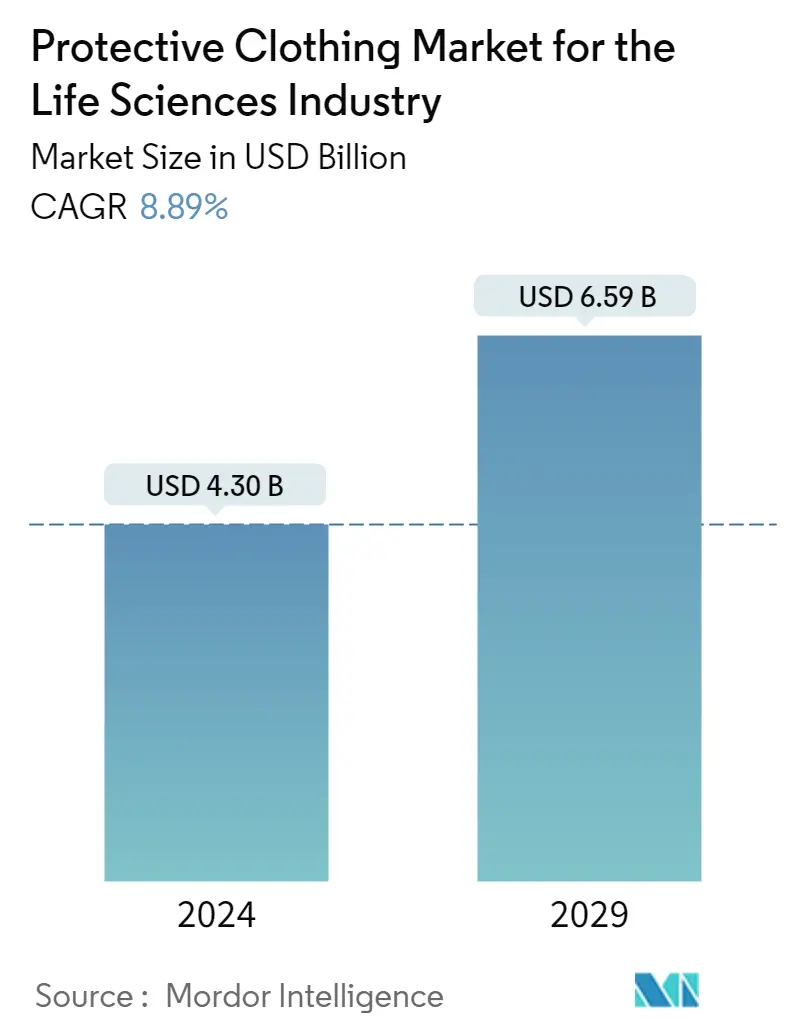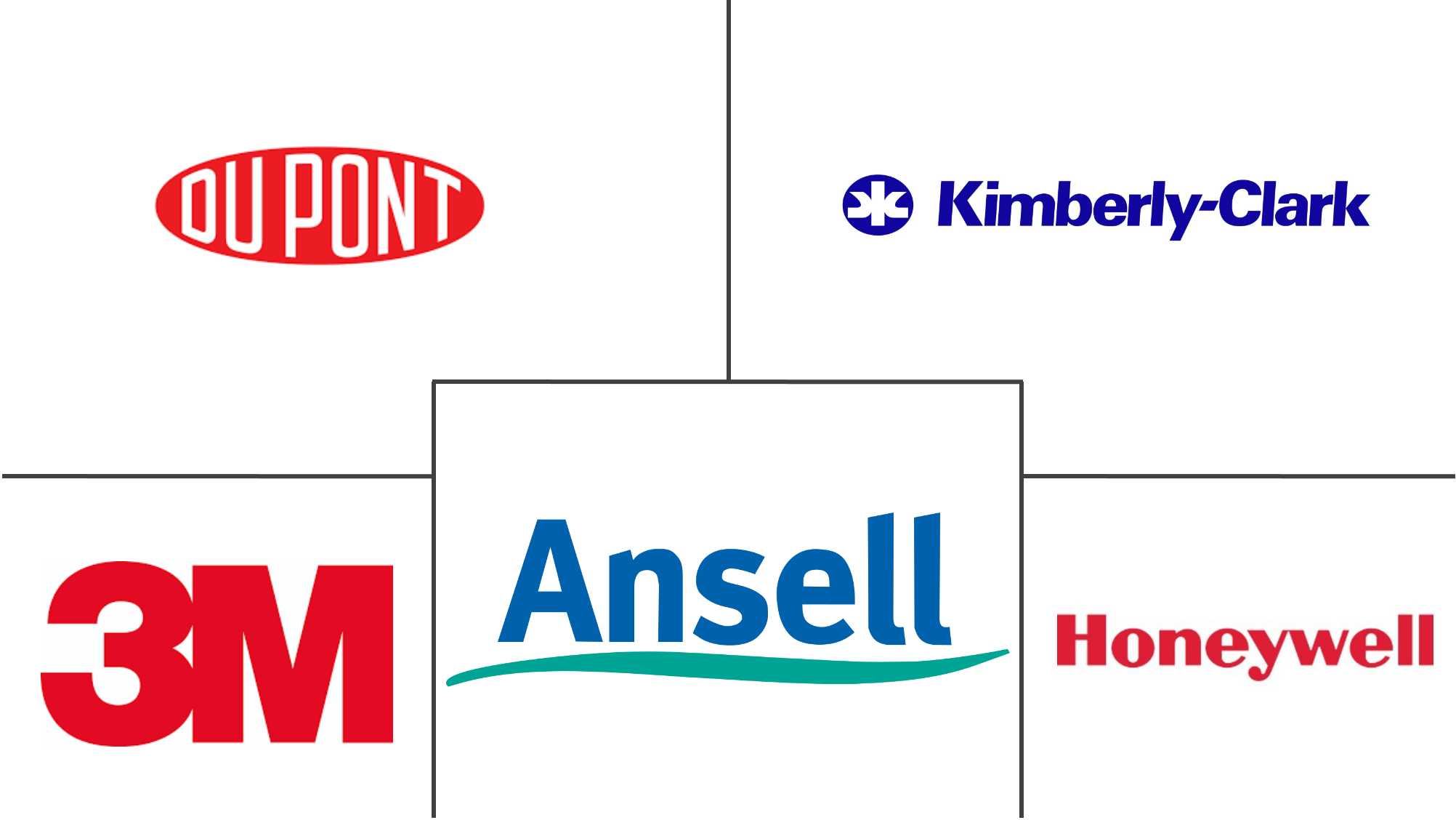Market Size of Protective Clothing Industry for the Life Sciences Industry

| Study Period | 2019 - 2029 |
| Market Size (2024) | USD 4.30 Billion |
| Market Size (2029) | USD 6.59 Billion |
| CAGR (2024 - 2029) | 8.89 % |
| Fastest Growing Market | North America |
| Largest Market | Asia-Pacific |
| Market Concentration | High |
Major Players
*Disclaimer: Major Players sorted in no particular order |
Protective Clothing Market Analysis
The Protective Clothing Market for the Life Sciences Industry is expected to grow from USD 4.30 billion in 2024 to USD 6.59 billion by 2029, at a CAGR of 8.89% during the forecast period (2024-2029).
The spread of COVID-19 around the world had a big effect on the growth of the protective clothing market in many different areas.The biggest part of the effect was the rise in sales and demand in the healthcare sector.COVID-19 had huge effects on health and the economy. When it first started, the sudden spread of the pandemic around the world caused panic.In a short amount of time, the demand for safety gear like face masks, gloves, face shields, air-filtering respirators, goggles, and gowns went up by a lot.
- The life sciences sector can be broadly categorized into three major segments (based on protective clothing applications): pharmaceutical, biotechnology, and medical. Generally, the relative growth of the life sciences segments is linked to the expenditure of regional markets for healthcare and innovation. In the current market scenario, almost all economies, especially developing economies, are increasing their spending on healthcare and innovation.
- Owing to the emerging manufacturing activity in the pharmaceuticals sector, the demand for protective clothing to be used in the preclinical and early-phase drug development and production environments is expected to experience increased demand. For example, the Chinese market is vibrant with preclinical and early-phase drugs, is a growing hub of biotech activity, and creates regional opportunities.
- The World Health Organization says that medical devices are all the tools that are used to diagnose or treat illnesses. This includes everything from surgical scissors to pacemakers and complex scanning equipment.Medical device equipment is classified into Classes I, IIA, IIB, and III based on the risk involved in handling the material.
- The way businesses in each province want to buy PPE in August 2021 is mostly the same as what the results of the PPES in May 2021 showed.According to the May 2021 results, firms in the healthcare and social assistance sectors led shortage expectations.
- Various government organizations recognize companies' efforts for their investment in the life sciences industry. For instance, in October 2021, UNCTAD awarded agencies for promoting new investment in health infrastructure, in the manufacturing of medical devices, pharmaceuticals, and vaccines, in the production of personal protective equipment, digital health, and life science research.
- Also, Levine Leichtman Capital Partners' company Technical Safety Services announced in September 2022 that it would buy CEPA Operations, Inc. ("CEPA"). They are based in Ontario, California. The company's services are performed across the lifecycle of a customer facility and ensure the compliant operation of controlled environments such as clean rooms, bio-safety cabinets, medical gas systems, high-purity water systems, laboratory equipment, and more.
Protective Clothing Industry Segmentation
Protective clothing is a garment or a piece of equipment that is designed to protect the wearer's body from injury or infection. It also keeps you safe from physical, electrical, heat, chemical, biological, and airborne hazards.
The purpose of protective clothing in the life sciences industry is to reduce a healthcare worker's exposure to the hazards posed by fire and heat, chemical exposure, and UV radiation. The administrative controls are not practical or feasible to reduce the risks to acceptable levels.
The protective clothing market for the life sciences industry is segmented by products (suits/coveralls, gloves, aprons, face masks and hats, protective eyewear and cleanroom goggles, footwear and overshoes, and wipes), type (disposable and reusable), application (cleanroom clothing, radiation protection, bacterial and viral protection, and chemical protection), and geography (North America, Europe, Asia Pacific, Latin America, and the Middle East and Africa).
The market sizes and forecasts are provided in terms of value (USD million) for all the above segments.
| Products | |
| Suits/Coveralls | |
| Gloves | |
| Aprons | |
| Facemasks and Hats | |
| Protective Eyewear and Cleanroom Goggles | |
| Footwear and Overshoes | |
| Wipes | |
| Other Products |
| Type | |
| Disposable | |
| Reusable |
| Application | |||||
| |||||
| Radiation Protection | |||||
| Bacterial/ Viral Protection | |||||
| Chemical Protection | |||||
| Other Applications |
| Geography | ||||||
| ||||||
| ||||||
| ||||||
| Rest of the World (Latin America and Middle-East and Africa) |
Protective Clothing Market for the Life Sciences Industry Size Summary
The protective clothing market for the life sciences industry is poised for significant expansion over the forecast period, driven by increased demand across various sectors such as pharmaceuticals, biotechnology, and medical devices. The market's growth trajectory is closely linked to rising healthcare expenditures and innovation, particularly in developing economies. The COVID-19 pandemic acted as a catalyst, substantially boosting demand for personal protective equipment (PPE) in the healthcare sector. This surge in demand highlighted the critical role of protective clothing in safeguarding healthcare professionals and patients, thereby accelerating market growth. The life sciences sector's diverse applications for protective clothing underscore its importance in maintaining safety and compliance in environments ranging from drug development to medical device manufacturing.
The market landscape is characterized by a high concentration of major players, including E. I. DuPont de Nemours and Company, Kimberly Clark Corporation, Ansell Limited, and 3M Company, who are actively engaged in product innovation and strategic partnerships to enhance their market positions. The introduction of advanced materials and technologies, such as Honeywell's new respiratory products and Toray Industries' chemical protection apparel, reflects the industry's commitment to improving safety standards. Additionally, the market is witnessing increased domestic manufacturing capabilities, as evidenced by Health Supply US's plans to establish new production facilities. These developments, coupled with regulatory support and investment in health infrastructure, are expected to drive the market's growth, offering substantial opportunities for both established and emerging companies in the protective clothing sector.
Protective Clothing Market for the Life Sciences Industry Market Size - Table of Contents
-
1. MARKET INSIGHTS
-
1.1 Market Overview
-
1.2 Industry Attractiveness - Porter's Five Forces Analysis
-
1.2.1 Bargaining Power of Suppliers
-
1.2.2 Bargaining Power of Buyers
-
1.2.3 Threat of New Entrants
-
1.2.4 Threat of Substitutes
-
1.2.5 Intensity of Competitive Rivalry
-
-
1.3 Industry Value Chain Analysis
-
1.4 Assessment of the Impact of COVID-19 on the Industry
-
-
2. MARKET SEGMENTATION
-
2.1 Products
-
2.1.1 Suits/Coveralls
-
2.1.2 Gloves
-
2.1.3 Aprons
-
2.1.4 Facemasks and Hats
-
2.1.5 Protective Eyewear and Cleanroom Goggles
-
2.1.6 Footwear and Overshoes
-
2.1.7 Wipes
-
2.1.8 Other Products
-
-
2.2 Type
-
2.2.1 Disposable
-
2.2.2 Reusable
-
-
2.3 Application
-
2.3.1 Cleanroom Clothing
-
2.3.1.1 Pharmaceutical
-
2.3.1.2 Biotechnology
-
2.3.1.3 Medical
-
-
2.3.2 Radiation Protection
-
2.3.3 Bacterial/ Viral Protection
-
2.3.4 Chemical Protection
-
2.3.5 Other Applications
-
-
2.4 Geography
-
2.4.1 North America
-
2.4.1.1 United States
-
2.4.1.2 Canada
-
-
2.4.2 Europe
-
2.4.2.1 United Kingdom
-
2.4.2.2 Germany
-
2.4.2.3 France
-
2.4.2.4 Rest of Europe
-
-
2.4.3 Asia-Pacific
-
2.4.3.1 China
-
2.4.3.2 Japan
-
2.4.3.3 India
-
2.4.3.4 Rest of the Asia-Pacific
-
-
2.4.4 Rest of the World (Latin America and Middle-East and Africa)
-
-
Protective Clothing Market for the Life Sciences Industry Market Size FAQs
How big is the Protective Clothing Market for the Life Sciences Industry?
The Protective Clothing Market for the Life Sciences Industry size is expected to reach USD 4.30 billion in 2024 and grow at a CAGR of 8.89% to reach USD 6.59 billion by 2029.
What is the current Protective Clothing Market for the Life Sciences Industry size?
In 2024, the Protective Clothing Market for the Life Sciences Industry size is expected to reach USD 4.30 billion.

